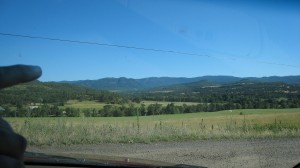 Caption:The ‘Forks’ from Hwy 140.
Caption:The ‘Forks’ from Hwy 140.
In 1951, I came to “The Forks” or the old Zundel place at the forks of the South and North Fork of Little Butte Creek. I grew up there for the next 12 years. In that time, I found, through boyhood wanders, many native sites showing how the land was used much earlier than the first local “pioneers.”
The fork itself provided major food sources. Certain fish runs went up the South Fork. Others turned up the North Fork. Gold Zundel, our neighbors right across the creek, told me of his childhood memories of two horses pulling nets full of salmon off the North Fork right before the confluence. There are a couple basalt slots in the North Fork that are very good fishing holes and would have been very good spear spots for salmon runs. Sadly, we only saw a few steelhead in our tenure at the ranch.
Under the North Folk trees along a bench below the ranch house was an Indian champ. Many artifacts were just lying on the ground every spring. (The few I saved have been dated by the Tribes as going back to 4,500 years ago to modern times and are from mineral source over by Ashland, so the tool path went up the South Fork.) I know the area was a camp as that is what folks used it for when I was growing up. It had a fresh spring and good shade, with fresh fish available. Many of our hay hands camped there instead of going home at night. Up and down the creek (the North Fork) Mrs. Abbott (the irrigation gate keeper’s wife) had amassed quite a collection of artifacts just left out by their last user. There were grinding spots and wide basalt places that showed long activity in food preparation.
The picture shows the tree line of the North Fork in the foreground. The fork is all the way to the lower right. The South Fork trees go past the hill where you can see the cut for the irrigation canal that comes out of the North Fork a quarter mile up the creek from what is shown. The ecosystems were much easier to see in the 1960s. The upper desert had many hollows of camas. Oaks abounded. So there was much of the local native diet within easy walk of the camp sites.
We raised beef there. Plus hay for winter feed. We moved in 1962, knowing Hwy 140 would change the place to where we could no longer take animals to our summer range permit lands. It was a magic time when you could still see what the original people lived on and where they did their food preparation. I don’t see as much as when I came back recently, so I’m writing this so folks squint a little and see that this was a happily settled area long ago.
~ J Michael Reid